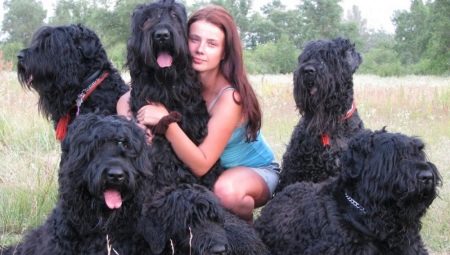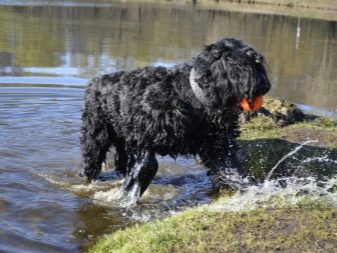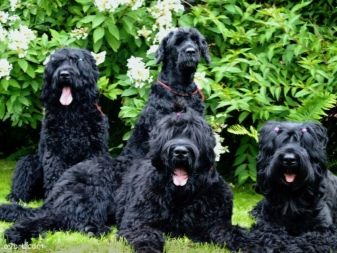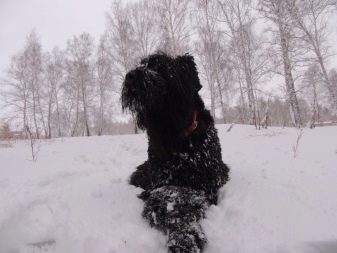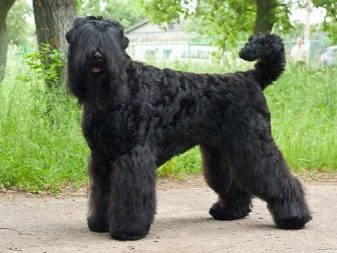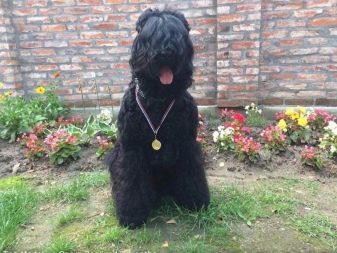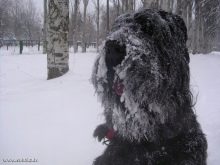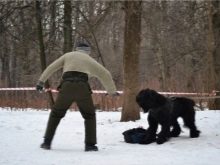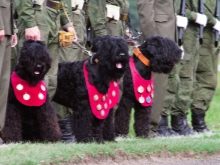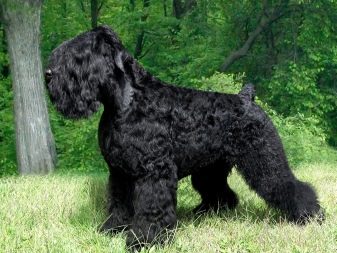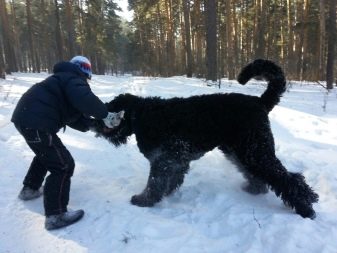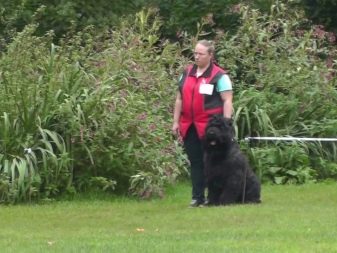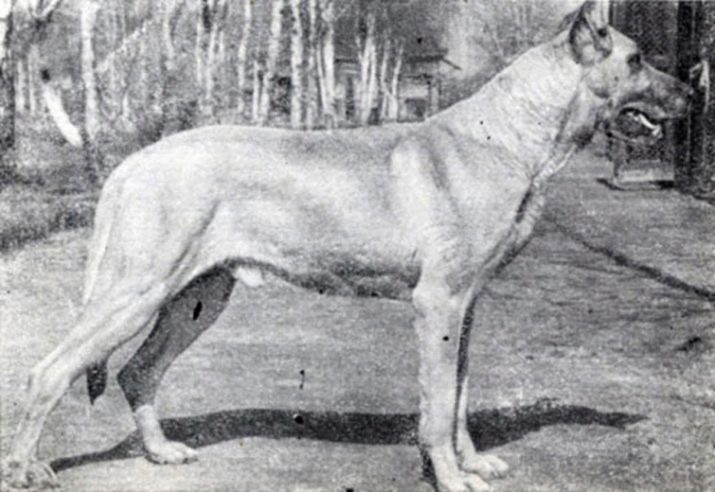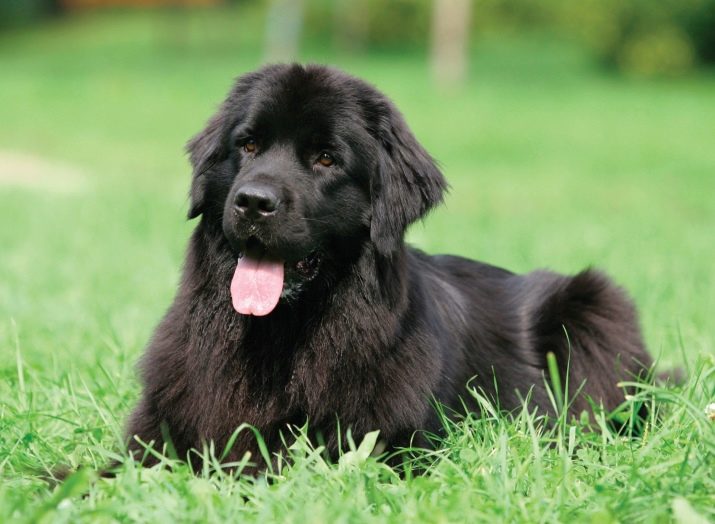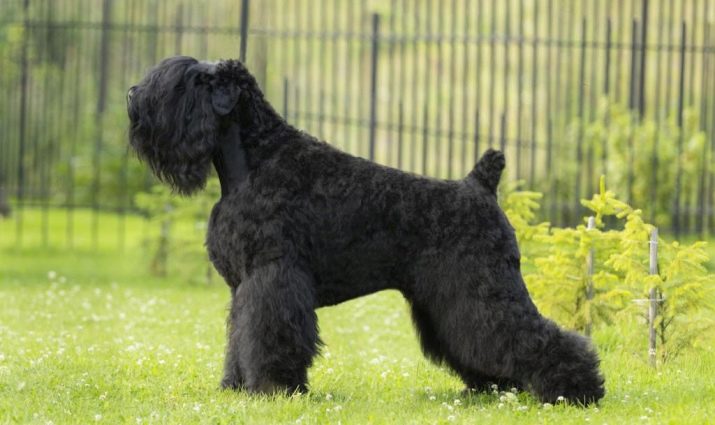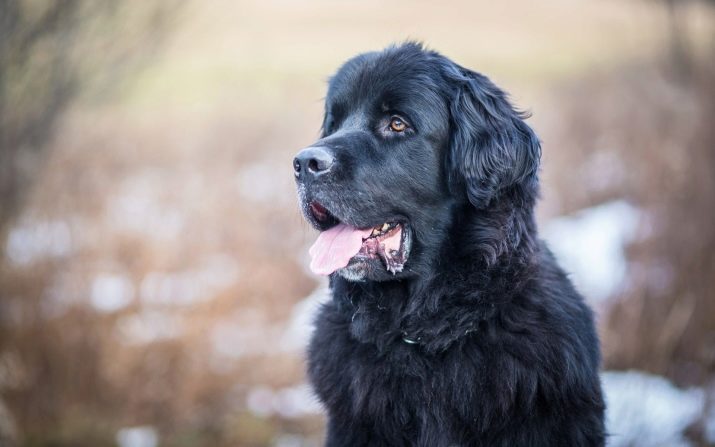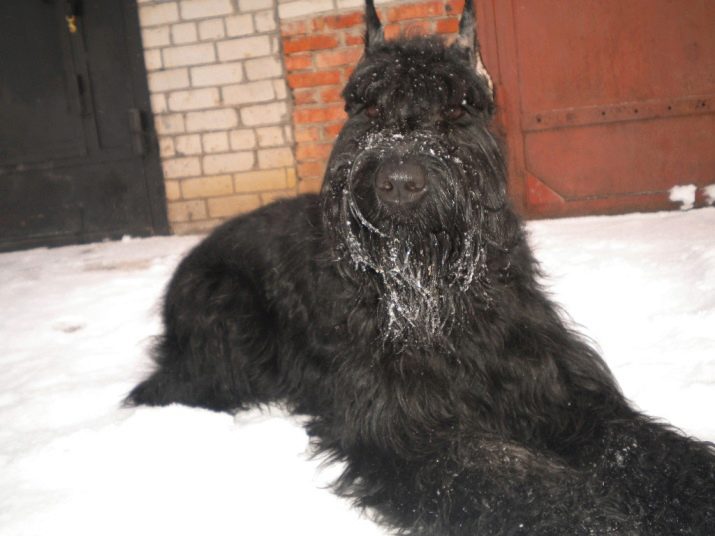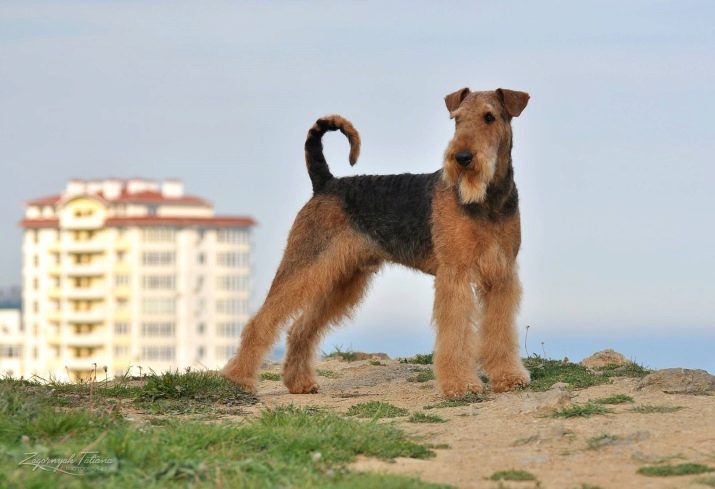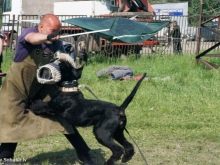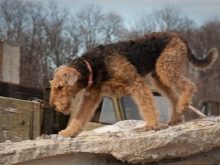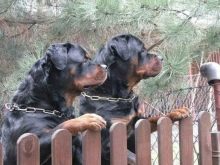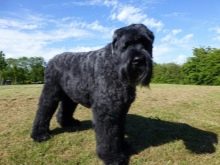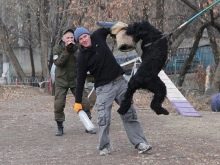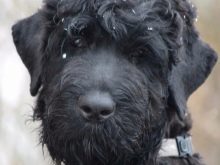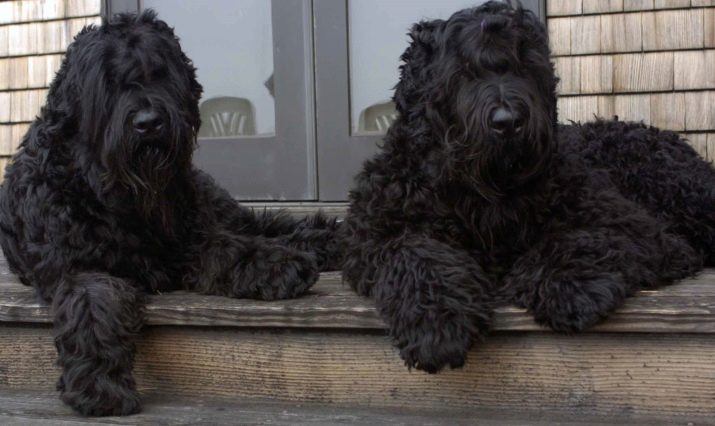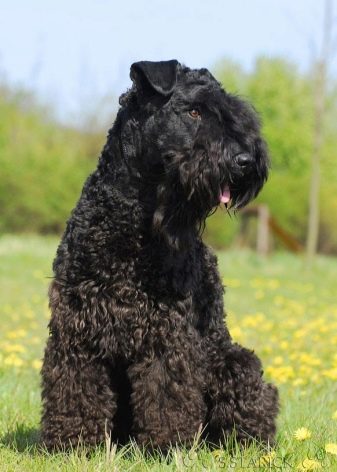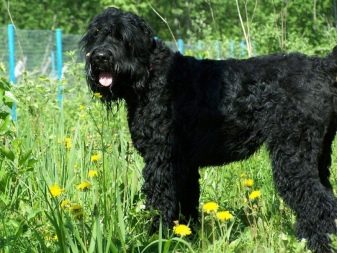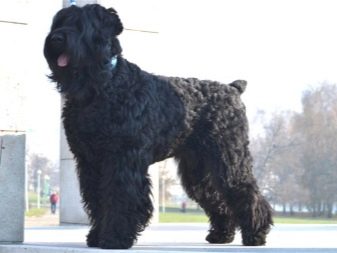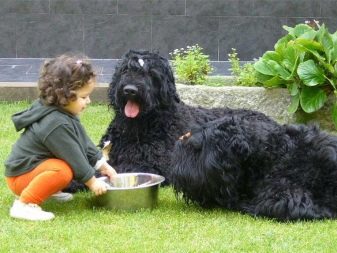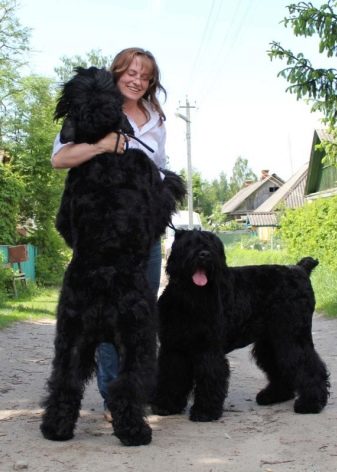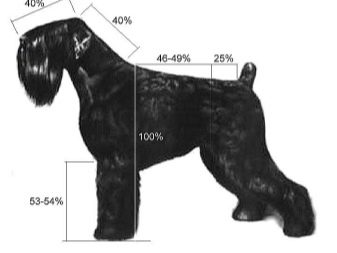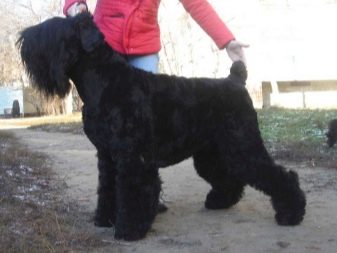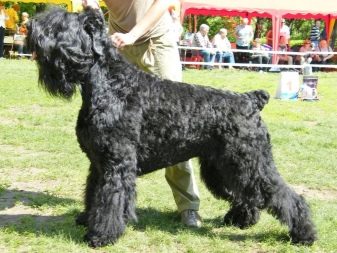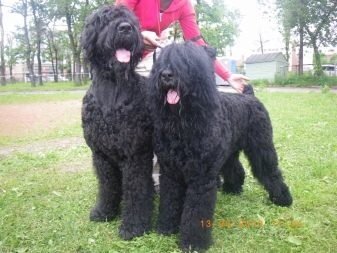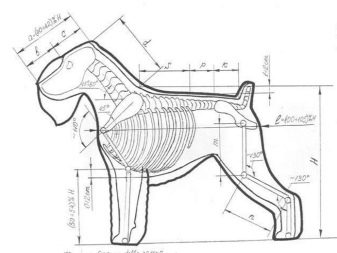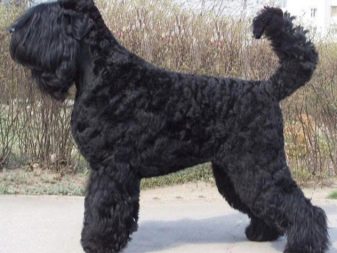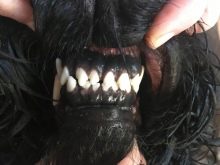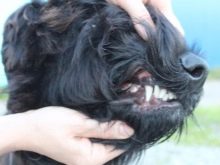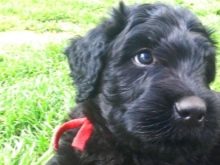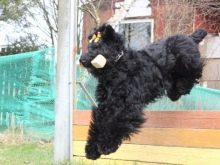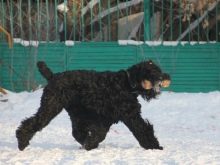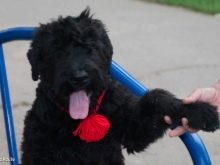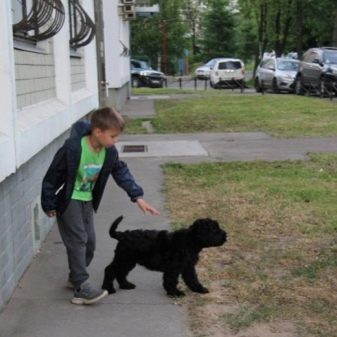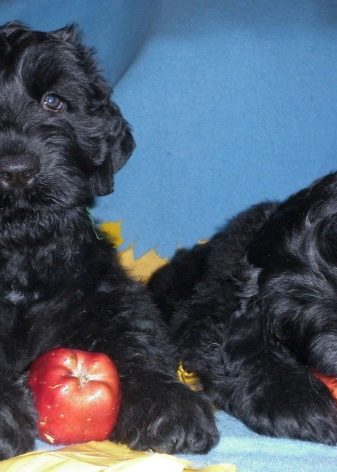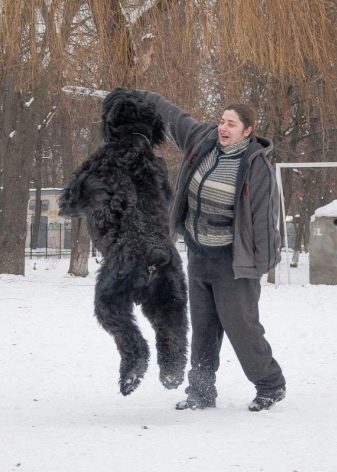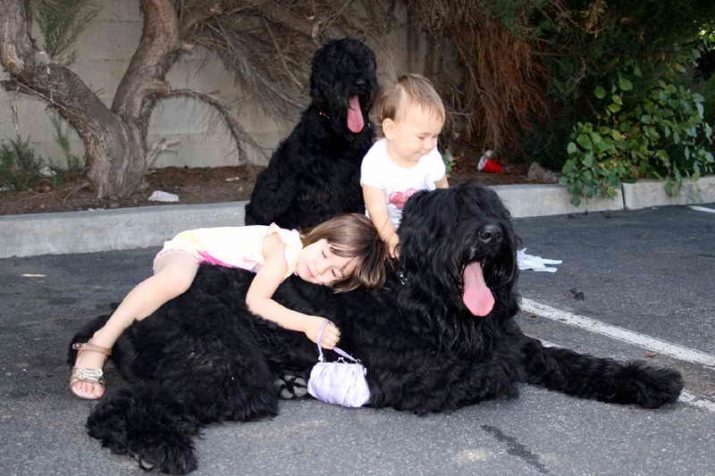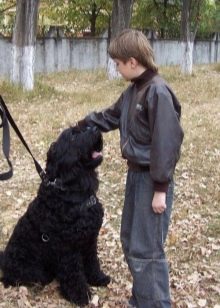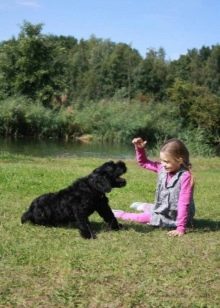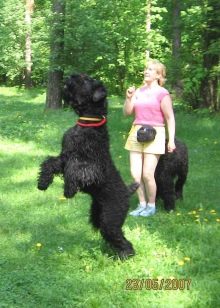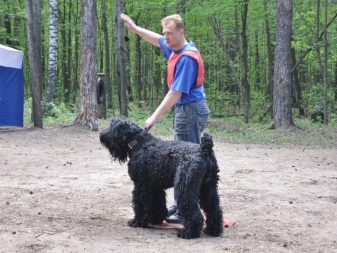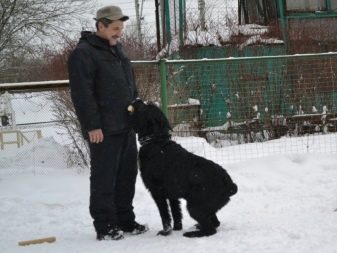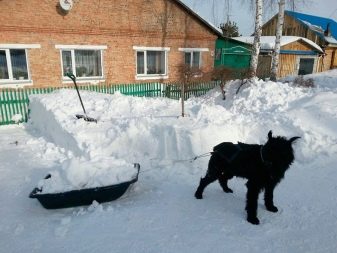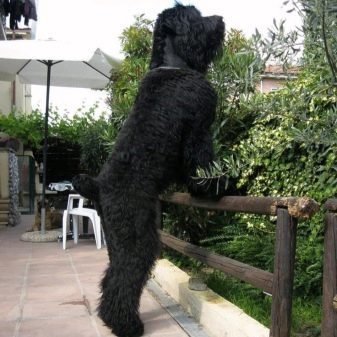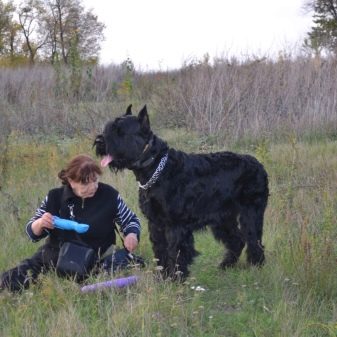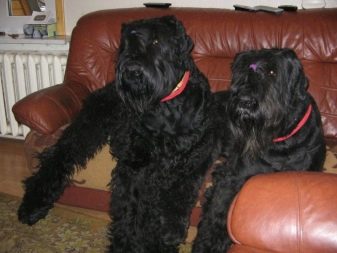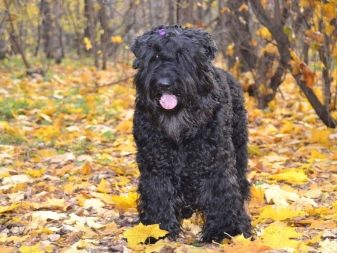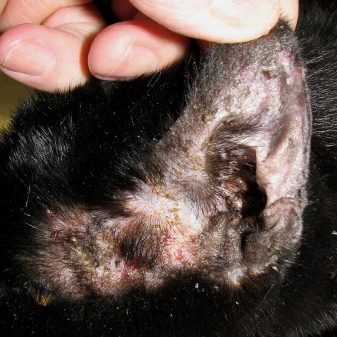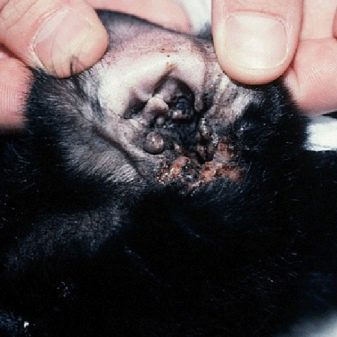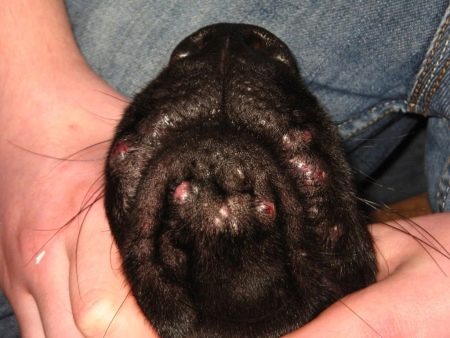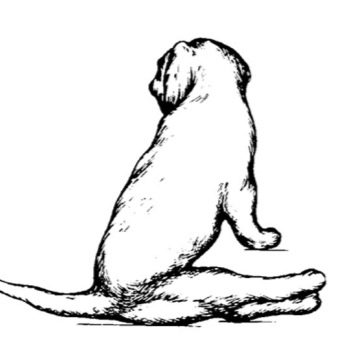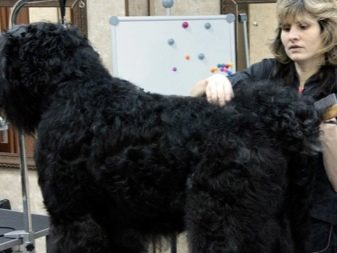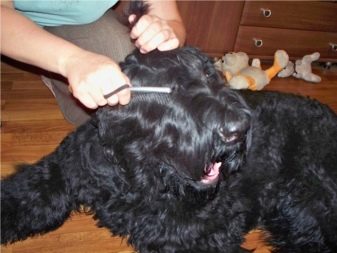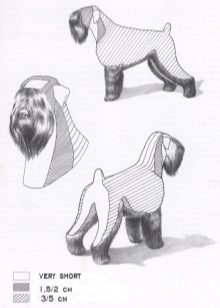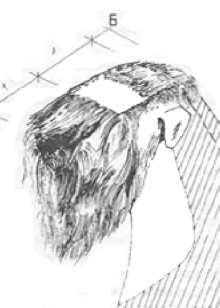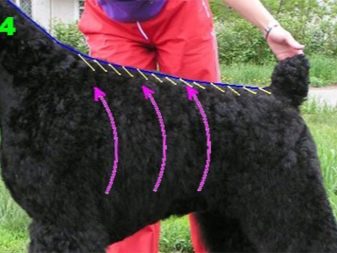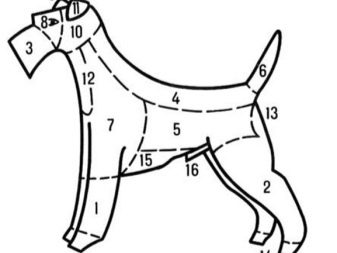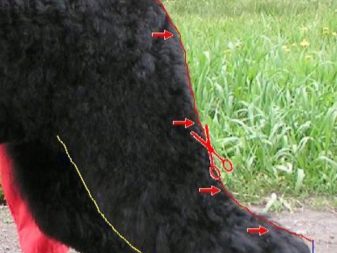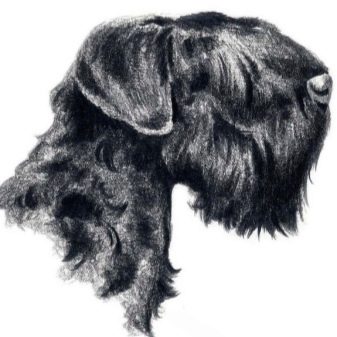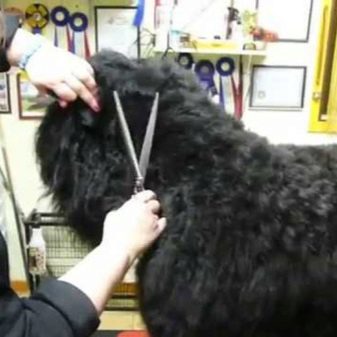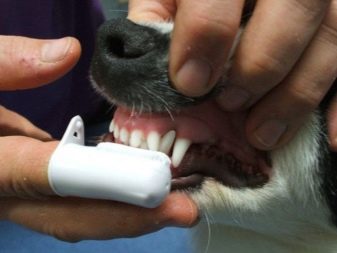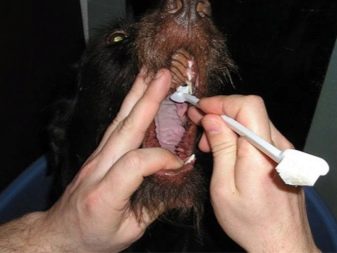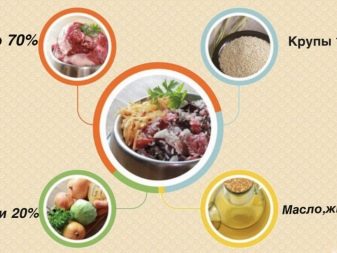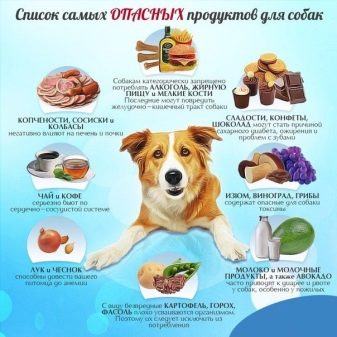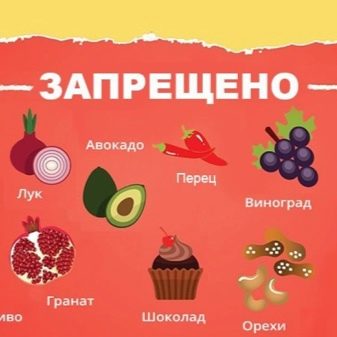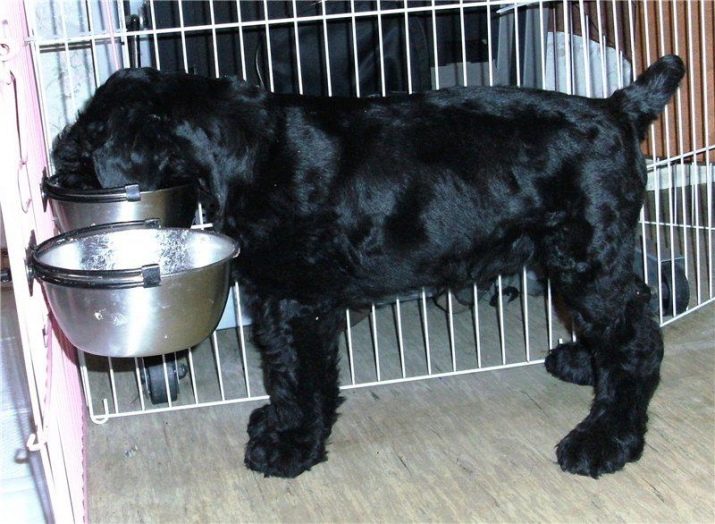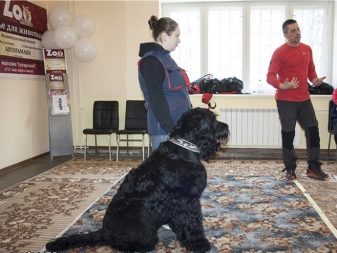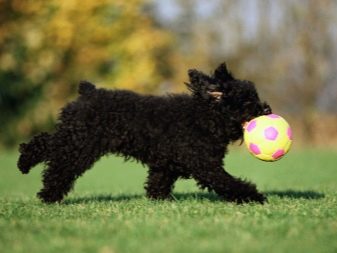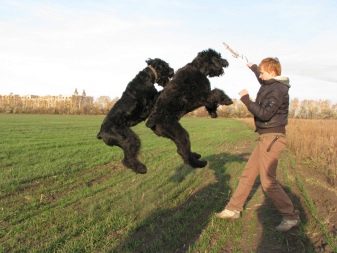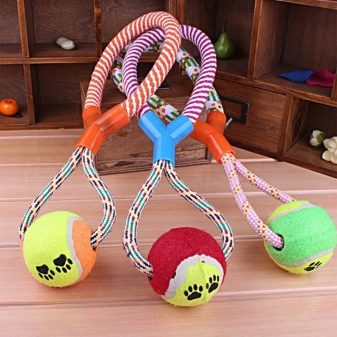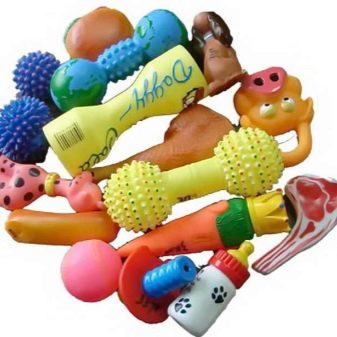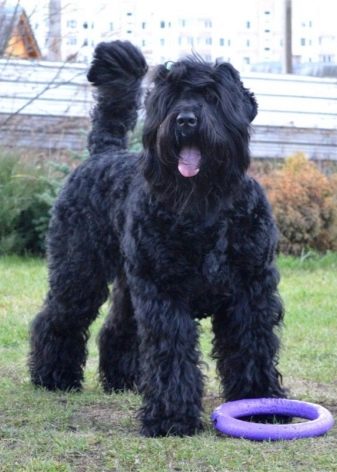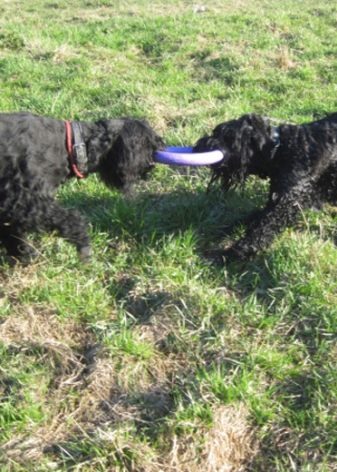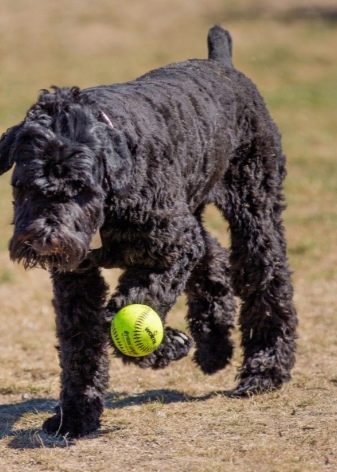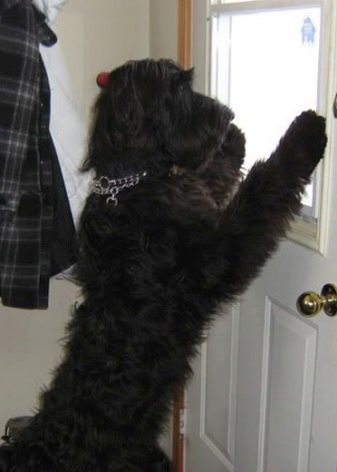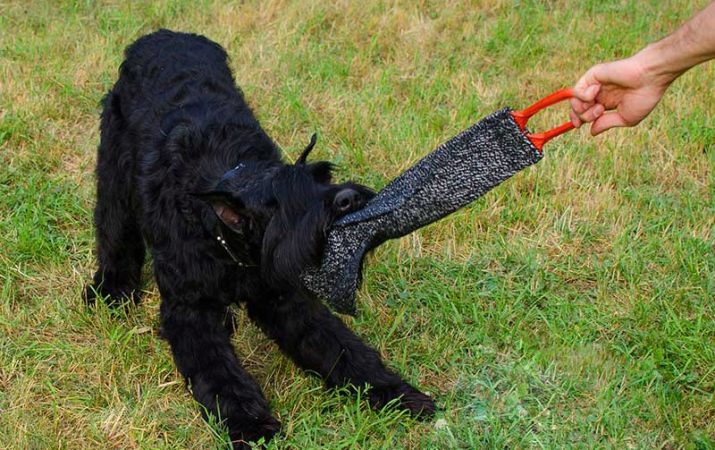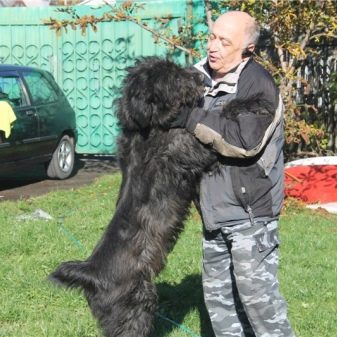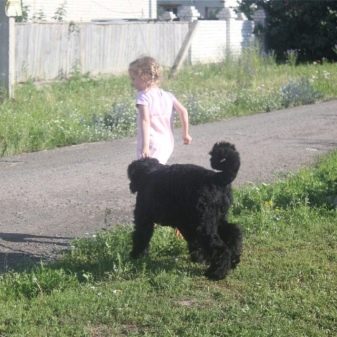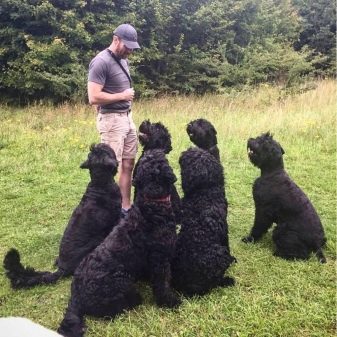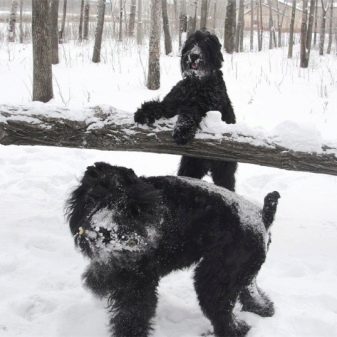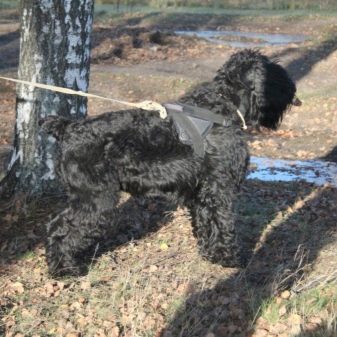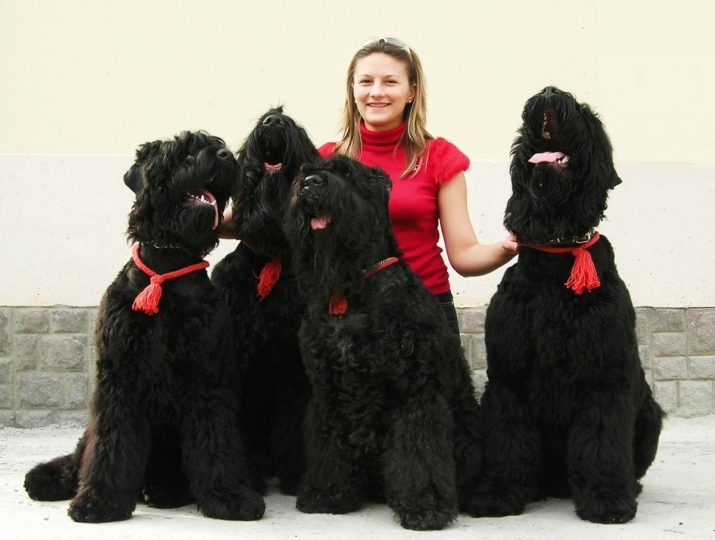Russia is a special country. Even dogs here are not like other countries. And among them stands out its grace, attractive characteristics of the black terrier.
History of origin
Literature and other sources on dog breeding are now more than ever before. However, a number of such materials, including with respect to the Russian black terrier, have made a number of serious mistakes. Someone uncritically perceives old stereotypes, someone writes custom materials or transfers his impression of her representatives to the whole breed. Because it is very important to imagine how things really are.
Up until the end of the 1940s, service dogs of the USSR almost always belonged to typical European breeds. Their disadvantages were too small size and adaptation mainly to the mild climate of Germany, England, France. Completely different animals were urgently needed:
- larger in size;
- physically developed;
- characterized by greater endurance;
- able to survive the cold and scorching heat;
- suitable for guard needs, protection of individuals, transport and property, patrolling the area.
The goal was set:
- achieve a strong constitution;
- make pets stronger and bolder;
- to increase the coat;
- to ensure the balance of the nervous system;
- improve scent and hearing;
- make it easy to train;
- ensure the use of dogs for protection in all climatic zones of an immense state.
Such diverse characteristics existed already then, but they were peculiar to different types of dogs. Therefore, a complex chain of interbreeding was undertaken. The result of the experiments was the elimination:
Moscow Great Dane;
Moscow diver;
Moscow Watchdog;
- black terrier
For this last breed used:
newfies;
- rottweilers;
- Giant Schnauzers;
- Airedale Terriers.
Giant schnauzers attracted the attention of breeders for their excellent working and protective properties, for their activity and assertiveness. Airedale terriers were used to improve the quality of wool and smell, to achieve a better orientation on the terrain. Erdels willingly penetrate into any hole, without fear of encountering enemies. From rottweilers, experimenters needed excellent protective qualities. This required to compensate for the lack of resistance to frost.
Along with the four main breeds, in the formation of the Black Terrier, the Great Danes of Moscow and the Russian Hounds took on their formation (albeit in very small numbers). Derived initially groups of mestizos began to merge with the third generation. Unfortunately, the participation of Giant Schnauzers at this stage was less effective than originally expected. The final formation of the black terrier occurred, according to official data, in the 4th generation of mestizo. Managed to get dogs that had:
- hard, slightly shaggy wool;
- strong and developed jaws;
- powerful limbs (without them a weighty body could not move);
- ears hung on cartilage.
Created in 1924, the Moscow kennel "Red Star" officially distributed information about the creation of the breed in 1956. At the same time, the standard of the black terrier is published in the breed catalog at the trade show. For the production of livestock used mestizo main breeds.Of these, selected copies that meet the requirements. Other dogs were transferred for work to the main center of military dog breeding or to other kennels of law enforcement agencies.
When the “Red Star” managed to develop a sufficient number of animals that met the standard, they began to be given to private owners. The first among them were the members of the Moscow club of service dog breeding. NN Nechayeva first took over the management of the project, then MA Anokhina changed it. Later, dogs began to receive other clubs of similar specialization.
Already the first full-fledged generation partially "parted" in other cities of our country. But part of individuals owners were forced to return to the nurseries because of the nastiness. At the same time, dog experts actively improved the characteristics of animals. The work was carried out initially under tight control from the initiators of the breed. Difficulties were even the allocation of factory, or at least genetic lines. When a solid result was achieved, dogs were appreciated even in foreign countries.
Since the work was conducted in the interests of the army and the Ministry of Internal Affairs, the dog experts were mainly interested in the actual characteristics and simplicity of the content. They tried to minimize the thickness of the scalp, which is always inconvenient in conditions of nurseries and service enclosures. But dog enthusiasts in the following decades have achieved a pleasant appearance. Nowadays, it is almost impossible to meet an RCT with hard, wire-like fur, and this is considered to be more of a marriage.
It is customary to divide terriers into two subtypes. One of them ("square") has:
- narrow oblong head;
- dry, strongly raised neck;
- straightened shoulder;
- flattened chest;
- excessively extended shin.
Other subspecies are distinguished by:
- pronounced rudeness of the constitution;
- muscle relief device;
- enlarged chest;
- strongly developed skeleton;
- incredible stability of the nervous system.
Breed description
In the characteristic of the Russian black terrier, it is not enough to limit the description of the standard and the main branches of this animal. It is necessary to indicate its other properties and psychological parameters. Inexperienced people can consider a majestic dog to be a complete black monolith incapable of displaying emotions. But this opinion is not true.
The absence of “eloquent” in their movements, like that of an EEB, ears, or the sad glance of St. Bernards, does not mean a little emotionality.
In the official standard, approved at the FCI level, the following dog sizes are indicated:
- in males - from 0.72 to 0.76 m;
- in females - from 0.68 to 0.72 m;
- taking into account the tolerances, the smallest dimension is 0.66 m, and the largest - 0.78 m.
Occasionally, taller animals may occur. But the official recognition of their black terriers occurs only when the original proportions and the correct appearance. The mass of dogs ranges from 45 to 60 kg. In accordance with the standard exterior should be:
- external massiveness of the body;
- proportional addition;
- considerable depth and width of the chest;
- perfectly visible withers;
- set back splayed with muscles;
- shortened lumbar area;
- oblong head;
- obligatory presence of beard and mustache.
The gums of a black terrier are dark in color. The neck is long. Although the ears are hanging, they are raised rather high. Typical for them is a triangular configuration. Dry eyelids rigidly fitted to the surface of the eyes. The eyes themselves are oval.
The dog has a standard 42 teeth, forming a scissor bite. All the incisors in the jaws are collected in one straight line. According to regulatory rules required to arrest the tail in the region of the 3rd vertebra. Straight legs should be placed parallel to each other.Elongated blades are placed at an angle of 90 degrees.
Rounded paws end in dark-colored claws. Of the colors for the Russian black terrier, only black is suitable, with insignificant patches of gray. The right dog is able to run long distances and jump far. Typical manners of movement are canter and lynx. The joints at the RChT are flexible, they bend without the slightest difficulty.
Character
Since, when developing a breed, she was initially conceived as an assistant in security work, the dog behaves with a person whom he does not know knowingly, wary. Terriers try by all means to protect the protected area and everything on it. They simply "hold the circle", blocking the passage of a certain line.
These characteristics make the breed suitable for personal protection.
If the upbringing was correct, the animal will save the owners and their children. At the same time, it will behave strictly, but not excessively aggressive. A characteristic feature of RFT at an early age is the propensity for fun and liveliness. But this does not prevent him from showing:
- fair autonomy;
- visible fearlessness;
- confidence in everyday activities.
As they get older, the dog will behave more and more decorously. However, this does not affect their reliability as guards and accompanying. As long as the RFT maintains normal physical activity (it does not become too old), he will fulfill his duties 100%. Puppies of this breed, like other large dogs, mature long enough.
You can only count on the readiness of a full-fledged service dog by 24 months.
A prerequisite for the normal development and exploitation of the black terrier is early socialization. If it is not produced, there will later be a series of problems in communicating with other animals and with people. Terriers in general tend to unwarranted stubbornness. A rational approach and daily classes in a special program help to circumvent this feature or to significantly weaken it. With all the severity of its appearance, the BRT is excellent with children and is able to tolerate calmly all their leprosy.
Pet feels a deep responsibility for all family members. By instinct, he perceives them as members of the pack, who need to be protected as effectively as they do themselves. From the positive features of the breed they call:
- powerful intellectual abilities;
- high performance at work;
- excellent endurance;
- calm and favorable attitude towards people;
- dedication and loyalty to the owners;
- propensity to active games and constant movement.
Comparison with a Giant Schnauzer
These two breeds are quite close to each other in biological terms, but the similarity between them in practice concerns only the external appearance. There are significant differences between them in working qualities. Russian black terrier takes up more space, requires more products. Yes, and deal with it will have much more than with large schnauzers.
However, the main difference between them concerns the same psychology.
Black animals are much calmer and more cool, which is clearly visible on a walk. Slowly marching dogs are much nicer to the owners than the ever-bustling schnauzers, and caring for their wool is very easy. The Moscow bearded man, however, more often falls asleep on the floor with endlessly crumbling hair. Giant Schnauzer wins a terrier with a single content and when used in competitions. But he is inferior to the Russian beast in suitability for security and guard duty, for keeping in a frosty climate.
Trainers really appreciate schnauzers, but black terriers are more popular with individual owners - it is more pleasant to work with them, and it gives many people pleasure. But when the dog is already trained, the BRT is better suited for a country house. There, the schnauzer will simply freeze, even if we are talking about relatively warm Russian regions. Another advantage of black dogs in the suburban security is calm and less inclination to bark.
Unlike impressed, they will easily miss suspicious strangers, but will no longer let them out of control without a command.
Lifespan
The vast majority of Russian terriers live 10-11 years. But individual instances can live to 14 years. Experts believe that the point here is not only in proper care, but also in impeccable genetic characteristics. Both of these components are equally important in practice. In general, the breed is less prone to hereditary diseases.
However, a significant portion of breeders with experience lead selection based on special medical tests. Experienced dog breeders and professional dog handlers unanimously advise to require documents on their passage and the result when buying. Significantly reduce the life of a pet can:
dysplasia of the hip and elbow joints;
damage to the ears;
- infection with pathological fungi;
juvenile paralysis.
Maintenance and care
Russian black terriers are still significantly different in hairline parameters. The best are those that are dominated by a rough awn, and the undercoat is small. It is a little worse to work with dogs in which these parts of the coat are balanced. It is most difficult to care for pets covered with a predominantly soft undercoat that dominates the bristle hair. In the first case, the care is very easy - you just need to shave the guard hairs on the body and on the hips every year.
The second type of wool is considered the most elegant, but will require systematic combing the dog. Without such a procedure, he will not be able to keep the texture for a long time. The third type of hair does not like both the owners and experienced dog specialists. Animals will have to comb every day.
Even with the observance of this requirement, there is a high risk of the appearance of mats
Beautifying hair, regardless of the type of base wool, are coarse in structure. They just need to wash and comb. Before beginning a haircut, you need to achieve a clean coat. There should be nothing in it except the undercoat and spine. All dead hair and undercoat parts should be removed immediately.
Shorn Terrier should look strong and confident. Inadmissibly the slightest impression of some kind of decoration. This is important even when caring for puppies, not to mention adult animals. Ears are cut short from the inside and outside. On the outside leave 0.5 cm of hair.
The forehead is trimmed with a typewriter, starting from the eyebrows. At this point, you need to make a square rectangular shape, approximately equal in width to the skull. At the junction of the forehead and the back of the head, a smooth transition between short and long hair is formed to create a kind of “cap”. Cheekbones flatten as much as possible, and recommend to cut the head in the form of a brick.
Shaving the hair on the inside of the neck is easy. But regardless of the cutting scheme chosen, any of its lines should be smooth. Hair is left on the body with a length of 3-7 cm. Exact numbers are determined for each dog individually. Required to show:
- manifestation of developed withers;
- roundness of paws;
- "Edge" on the outer side of the thigh and on a certain part of the leg;
- elongated hair on the hind legs.
Grooming is too important a matter to try to fully produce it on your own. This is especially true when there are plans to participate in a dog show. RFT is required to cut and launder. Washing is required whenever a negative sensation or a desire to rinse your hands appears when you touch and stroke the dog. When the terrier has been washed, but not combed, it turns out even worse - the mats will fall down to the “felt boot” state.
The beard is required to handle as carefully as possible. It is constantly clogged with food, moistened with water. Unwashed and dry beard becomes a favorable place for the development of fungus, so the terrier can smell bad. There is no point in shaving a beard. If she is so annoying owners emotionally, then they should buy another breed.
Combing increase when there is a molt. This allows you to significantly speed up the renewal of hair. Strict claw trimming is strictly required. Carry it out when their natural growth begins to create problems for the animal. If claws are ground on hard soil or asphalt is enough, they should not be further cut.
Regardless of this circumstance, it is required to remove the hair growing inside the auricles and sulfur collected there. Without this cleaning, the dog can become seriously ill. Another important point in the care is cleaning the teeth with a special paste. This procedure is carried out at least 1 time in 72 hours. It is strictly forbidden to use toothpastes designed for people!
What to feed?
Despite the fact that RFTs belong to the same species as wolves, it is undesirable to feed them with one meat. A diet of this kind is simply unsuitable for animals. The common opinion about the need to increase the nutritious nutrition of cereals is wrong. Any carbohydrates for four-legged “empty” and over-modest daily allowances simply cease to digest. But in the choice between factory feed and natural products, the owners are not limited in any way.
Adherents of feeding dogs with natural food should know the optimal ratio - 30/70. 7/10 daily servings should fall on the proteins presented:
- limited-fat meats;
- sea fish;
- by-products (they are given maximum 1 time in 7 days).
The rest of the feed should fall on vegetables and fruits, dairy products, cereals. Of all the fruits choose only those that are guaranteed not to cause allergic attacks. Another nuance - the strictest ban on milk in its pure form. Strongly unacceptable to feed Russian terriers:
- sweet food;
- smoked meat of any kind;
- salted foods (regardless of the intensity of salting);
- spices-rich dishes;
- semi-finished products;
- bread, other bakery products.
Of the ready-made factory mixes, holistic is best suited. A slightly worse super-premium manifests itself. The high cost of these feeds is fully justified, because they include not only protein, but also other trace elements, vitamins. Because the terrier's body will work like a clock.
Mixing natural food and industrial feed is unacceptable. It does not matter if they are consumed at the same time or in succession. Inevitably, you get an unpleasant result - an imbalance of the digestive system. Whatever feed is used, it should be consumed in a limited amount. From early childhood puppies need to develop a clear discipline in food. Overeating invariably leads to obesity, and behind it joint problems are “tightened up”.
Sometimes at the final stage of maturation these joints are severely deformed. Curvy-legged, unpleasant-looking dogs are obtained. Bowl with food should be placed on a small elevation. This is the location of the feeder best fits the physiology of the dog.
Another nuance - containing RFT, will have to put a carpet on the floor. Walking on linoleum, parquet or laminate, a pet hurts its limbs. They are often deformed and develop incorrectly. Somewhat unexpected for dog breeders will be a ban on frequent stroking on the head. In terriers, because of it, the line of growth of the ears may be distorted. Small puppies are required to keep out of the stairs, closets and other high places. A fall from them almost inevitably provokes serious injuries.
Combing and bathing terriers should be immediately after purchase. At an early age, this procedure is done as often as possible. If the dog is not washed and not combed at this time, it is absolutely impossible to accustom them to such manipulations later. If these requirements are met, the health of the pet is guaranteed. However, it is equally important to develop suitable practical qualities.
Upbringing and training
Terriers need a game because it represents:
- a burst of energy;
- essential element of learning;
- A valuable way to improve health.
Even when the dog matures, it needs to play to bolster its status in the “pack”. And because dog handlers, amateur trainers are actively using game elements of training. It is almost useless to struggle with the instinct that tells everything on the way to gnaw, bite and scratch. But you can not provoke a terrier once again - let all your belongings be inaccessible to him. Selection of toys that can meet those same instinctive needs, must be carried out individually.
There are a lot of options:
- balls;
- large beef bones;
- tarpaulin, twisted to the state of "sausage";
- "Squeaker";
- special sticks;
- Stuffed Toys.
As toys you cannot use old shoes, clothes (and even parts of them), furniture parts. Animals, in spite of all intellectual achievements, are in principle incapable of understanding why it is possible to play with one thing, but with others that are outwardly similar, it is impossible. The dog distinguishes everything by smell, and the category “used — not used” above the limits of its presentation. It is possible to ward off a dog from the legs of a chair or other objects by using cologne or another substance that the terrier will not like.
When the interest in the same leg is shown only once at the height of the game, you need to distract the dog and provide it with a more interesting subject.
You can do otherwise, using the resistance reflex. For this puppies open mouth and invest "forbidden" object forcibly, but without self-harm. Older terriers deserve a different treatment: the owner must say “Listen” to them, demonstrate alertness and go to another room. One such measure is usually sufficient to explain the unacceptability of a particular behavior. The rigid prohibitive command "Fu" is given only in a particularly responsible or especially difficult situation.
The owner of the RFT must clearly understand that this is an extremely powerful means of action, almost an extreme measure. The excessive use of such an order devalues its meaning. In addition to training, you will need to take care of how to properly leave the puppy at home. Even before leaving for work or other long absences, you need to walk it. It is useful to pronounce the phrase "I leave for the service," "I will soon" and so on.
Although these are not commands, they must be repeated every time they leave home and, moreover, in a strictly unchanged form. Then the animal will get used to these formulas and will have to wait exactly as long as necessary when they are pronounced. When a terrier is thrown a subject (any), you need to look where it drags it. If he goes to the owner, he will have to command the Aport. Categorically it is impossible to play the tug of various things with dogs that have no teeth or jaws.
If the RCT exhibits leadership propensities, it is absolutely impossible to give in when dragging. Otherwise, the authority of the owner will be undermined and one should not count on the obedience of the dog.
It is useful to use and throwing toys between family members. At the same time, a terrier should monitor the movement of objects and the movements of people themselves. Sometimes it is even worth starting with intentional mistakes. This will increase the interest of the pet. It is strictly forbidden to play games that are accompanied by the hosts running around for animals.
On the street, playing with terriers is necessary only with homemade toys.. Otherwise, they will pick up everything from the ground. Elements of struggle and messing around in games are quite acceptable and even desirable. But it is required to immediately stop the game when the puppy starts to bite seriously. From a very early age, he must master the installation that the owner has absolute immunity.
But curiosity and interest in everything around him is welcome. In this case, it is necessary to categorically exclude any provocation of an attack on other living beings. If the pet shows aggression itself, it must be gently but firmly suppressed. It is useful to learn the command "watch." This order will come in handy when a suspicious person (car) appears nearby, or when children play in the yard, and in some other cases.
It is advisable to walk the RCT along with well-bred dogs. Otherwise, the imitative reflex will force to adopt not the best forms of behavior. Near any roads and railways, even when they are empty, you need to stop, look around. At the intersection of the highway should be given a command "Beside". Running and playing with a puppy is easy to combine with mastering the team. "Barrier".
When a terrier is not suitable for a signal from the owner, it is either a formidable manifestation of disobedience or a hearing problem.
The “me” command should be executed immediately and unconditionally, regardless of all other circumstances.. In order to achieve the execution of the order, it is always necessary to summon the RCT without subsequent punishment or taking away “interesting” objects. Let the call will always be pleasant - then the result will please the owner. The next order you need to master is an instant stop at the command of the host.
Restraining commands are worked out mainly with painful negative stimulation. It should be applied not only in case of refusal to execute the order at all, but also when braking, sluggishness. Trainings need to be repeated again and again, achieving an excellent result. With persistent failures it is better to resort to the help of specialists. Strictly prohibited:
- let the dog on the working and dining table;
- allow her to walk in the kitchen once more;
- allow to lie down or sit on the sofa;
- to achieve a total aggressive reaction to every passer-by or every car for no reason.
Owner reviews
The Russian black terrier is considered by many owners to be a poorly trained dog. But those who know how to achieve obedience, rejoice in this pet. Easier to train an animal at an early age. In reviews about black terriers also note:
- jealousy in the protection of the territory;
- uncompromising protection of people;
- love for all family members;
- painful reaction to the slightest conflict within the family;
- difficulties in the care of wool;
- external beauty;
- the need for constant communication;
- resistance to rude behavior.
About the features of the breed, see the video below.
